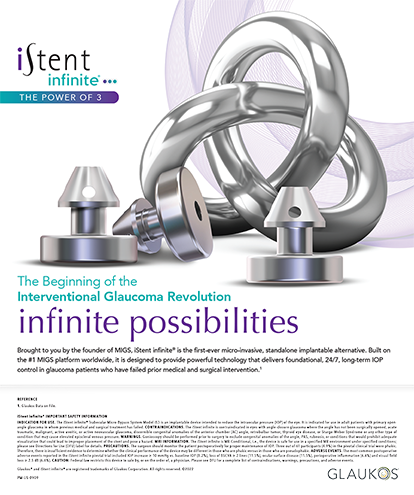
Two of the challenges surgeons face in maximizing the outcomes of toric IOL implantation are measuring true corneal astigmatism (magnitude and meridian) and choosing the appropriate level of toric IOL correction. Several methods are available to measure corneal power and astigmatism, including manual keratometry, automated keratometry, corneal topography (Placido imaging and grid-based reflective technology), and corneal tomography (Scheimpflug imaging, optical coherence tomography, and slit-scanning technology).
KERATOMETRY AND CORNEAL TOPOGRAPHY
Both the anterior and posterior corneal surfaces contribute to its refractive power, with the anterior surface adding positive power and the posterior surface adding negative power. In general, keratometry and corneal topography measure only the curvature of the anterior surface. They determine the radius of curvature by measuring the magnification of individual spots arranged in one or more rings (automated keratometry), multiple concentric rings (Placido imaging), or a grid of spots (color LED point-source topography) reflected off the anterior surface/tear film (the first Purkinje image).
In the United States, when these devices convert curvature to power, the corneal index of refraction is decreased from 1.376 to 1.3375 to account for the negative power of the posterior surface. In Europe and elsewhere, this adjusted index of refraction may be 1.3320. An inherent assumption of these techniques is that the posterior corneal astigmatism mirrors the anterior corneal astigmatism (ie, the locations of the steep and flat meridians on the back of the cornea are identical to the locations on the front of the cornea).
P. Dee Stephenson, MD, shares why it is important to her to address astigmatism.
CORNEAL TOMOGRAPHY
Corneal tomography measures both the front and back surfaces of the cornea. These technologies measure elevation and convert elevation to curvature to determine the overall corneal power. Total corneal power is calculated by combining the measured contributions of the front and back surfaces, typically by ray tracing via Snell’s law using the true refractive indices: 1.376 for the cornea and 1.336 for aqueous. By using separate measurements of the front and back corneal surfaces, the assumption that posterior astigmatism mirrors anterior astigmatism is removed.
POSTERIOR ASTIGMATISM
It has been shown that, while the steep meridian of the anterior corneal surface transitions from vertical to horizontal (with the rule [WTR] to against the rule [ATR]) with age, the steep meridian on the posterior surface remains vertically oriented for most individuals, regardless of age.1 Because the posterior corneal surface has negative power, the vertical location of the steep meridian equates to additional ATR astigmatism. If total corneal astigmatism measurements are based only on the anterior surface, this may lead to overestimation of astigmatism magnitude in WTR eyes and underestimation in ATR eyes.2 Although the preoperative manifest refraction may include a component of lenticular astigmatism, it can also provide clues to the contribution of the posterior cornea, especially if the refractive astigmatism exceeds the anterior astigmatism in ATR eyes and is less than the anterior astigmatism in WTR eyes.
Tip From the Top
By Warren E. Hill, MD

If there is one thing I might suggest regarding preoperative measurements for a toric IOL, it would be to begin using the K calculator feature developed by Graham D. Barrett, MD, and recently added to the Barrett toric calculator (www.ascrs.org/barrett-toric-calculator). The K calculator integrates the keratometry (K) readings from multiple devices.
According to Dr. Barrett, if only one device is selected, the integrated K readings will reflect that single device. If two devices are selected, then the integrated K readings will be the vector mean or average of the two instruments. If three devices are selected, the integrated K value will be the vector median of the three devices.
Initial testing using a combination of K values from the Lenstar (Haag-Streit), IOLMaster (Carl Zeiss Meditec), and Pentacam (Oculus Optikgeräte) has shown a significant increase in accuracy for residual refractive astigmatism of 0.50 D or less.
Warren E. Hill, MD
- private practice, East Valley Ophthalmology, Mesa, Arizona
- (480) 961-6130; hill@doctor-hill.com
- financial disclosure: consultant to Alcon, Carl Zeiss Meditec, and Haag-Streit
Although the measurement of posterior astigmatism with modern corneal tomographers has improved greatly, individual measurements may still be subject to significant variation; therefore, population norms may be more useful. On average, the posterior component equates to 0.30 D of additional ATR astigmatism in eyes with anterior ATR astigmatism and 0.50 D in eyes with anterior WTR astigmatism. While the posterior component in ATR eyes changes very little as anterior astigmatism increases, in WTR eyes, it generally gets larger as anterior astigmatism increases and may exceed 0.80 D in some cases.
Elevation-based tomography provides valuable information on both the front and back of the cornea, but it must do so by analyzing cross-sectional images. Distinguishing small differences in curvature in these images requires very high resolution, on the order of microns. Direct reflection-based measurements are on the order of millimeters, making curvature determination much easier. Color LED point-source topography is rapidly evolving and can now measure reflections from the posterior corneal surface (the second Purkinje image). This technology may improve ophthalmologists’ ability to measure the posterior cornea and total corneal astigmatism.
No matter what methods are chosen to measure corneal astigmatism, care must be taken to assess the measurement quality and ensure that the astigmatism is regular. Reflective technologies can be negatively influenced by tear film quality and other causes of surface irregularity. As such, cataract patients must be carefully screened for dry eye, and epithelial basement membrane dystrophy, among other screenings. Direct visualization of the reflected mires or grid spots is informative and should always be a part of the interpretative process. Automated keratometers and most tomographic systems provide indices that quantify the quality of their measurements. Care should be taken to review these measures before making any final determinations of corneal astigmatism.
CONCLUSION
It is advisable to use more than one method, such as automated keratometry and corneal topography/tomography, to measure corneal astigmatism and to reconcile any disagreements between devices. No single device is infallible in all situations; thus, comparing the measurements of several devices can help to eliminate outliers and improve overall accuracy.
1. Koch DD, Ali SF, Weikert MP, et al. Contribution of posterior corneal astigmatism to total corneal astigmatism. J Cataract Refract Surg. 2012;38(12):2080-2087.
2. Koch DD, Jenkins R, Weikert MP, et al. Correcting astigmatism with toric intraocular lenses: the effect of posterior corneal astigmatism. J Cataract Refract Surg. 2013;39(12):1803-1809.




